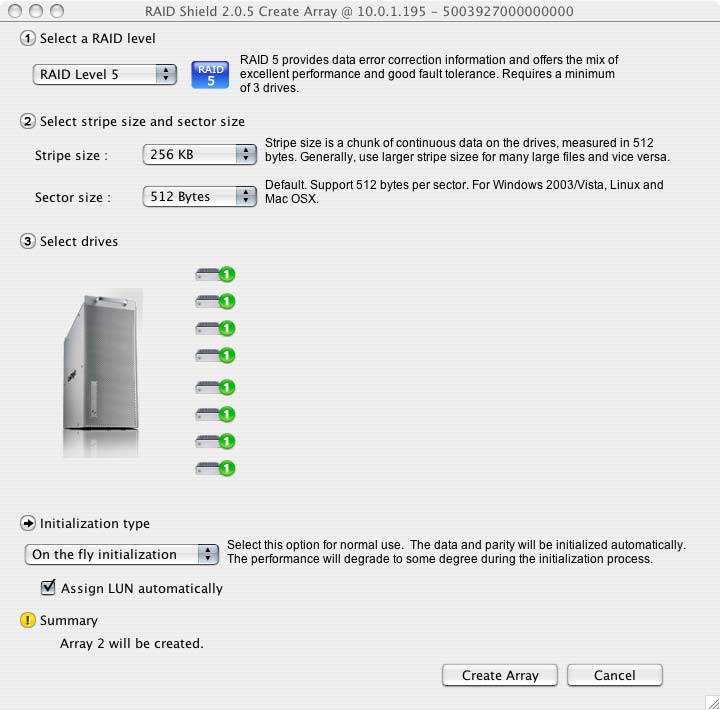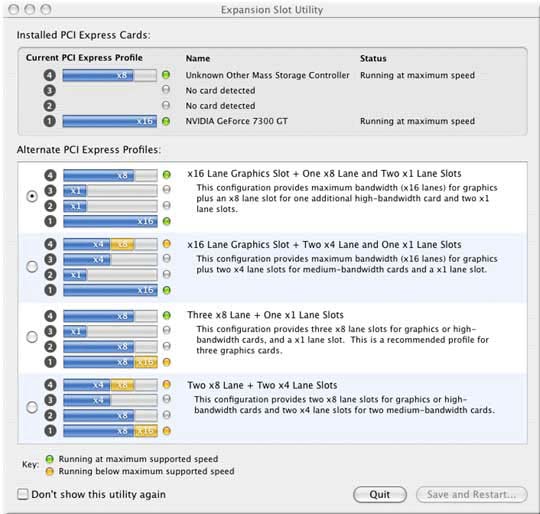There's only so much that you can actually write about when you're
reviewing a drive system and it gets harder all the time because
there are many great products out there, but I've been taking
a CalDigit HDPro PCIe RAID for a spin - even got it some work
on a film for a couple of weeks - and I thought I'd share my
thoughts.
If you're looking for the super-technical
review, Kevin
McaAuliffe at Digital Media Net and Ned Soltz in DV
Magazine have already done that. This will be more my thoughts
and experience with the HDPro.

The HDPro is a complete system: enclosure, drives, carriers,
cable and card. Add power and a G5 PowerMac or Mac Pro Pro with
PCIe slots and you're good to go. Setup is straightforward and
simply involves sliding the drives in through the back doors
on the unit. The front is styled to match MacPro product lines
and sits nicely beside them, although the HDPro is a lot smaller.
But fully loaded with eight drives, it's not a lot lighter.
The cable and connector were unfamiliar
because it's not an adapter card in the traditional sense. The
HDPro, like my Blackmagic Design Multibridge Pro, uses a direct-to-PCI
Bus connection, not an adapter card like Fiber Channel or SATA.
The HDPro speaks native PCIe bus so it's as fast as the host
computer can talk too it, because there's no signal translation
from PCIe to (say) SATA. It's fast enough to make it a reasonable
alternative to Fiber for uncompressed HD media. To me the
best feature of this method is that there's a single, robust
cable - there's not the hassle of bringing out 8 SATA cables.
I have a client with that configuration and I hate sliding his
computer out for fear that one of the 12 SATA plugs will be dislodged
when we push it back. None of that with the HDPro.
In fact, about the time the HDPro arrived
I was designing a workflow for an upcoming movie and my recommendation
was the HDPro. Well, it was my recommendation, until the company
I was preparing the system configuration for said that they wanted
to move the storage onto their Storage Area Networks (SAN). SANs
are Fiber Optic based and the HDPro, because it taps directly
into the PCIe Bus, is storage for a single computer. Never-the-less,
the HDPro did manage to ride to the rescue on that project anyway.
Installation was a breeze: Fit the card
into the host MacPro (or in my case a Quad G5 PCIe), install
the software, restart and it was ready to go. The HDPro is a
fast, big pool of storage. By default it's configured for RAID
5, which means that you lose about 20% of the installed drive
space, but you can lose one drive without losing data. Since
it takes about 24 hours for the RAID to rebuild itself after
a drive failure - with some performance loss during that time
- RAID 5 leaves that 24 hour window where a second drive failure
would be catastrophic, causing real data loss. So far, I've been
happy to recommend RAID 5 as the default for storage with the
best compromise between data capacity and reliability. Those
who want more fault tolerance can reformat to RAID 6, where two
drives could be lost at any one time without data loss. The trade-off
is a slight drop in storage capacity.

The HDPro comes with its own RAID Shield
software, and I obediently followed instructions to add the HDPro
to the RAID Shield software, even though it was already mounted
on the Desktop! The RAID Shield software isn't essential for
everyday operation, unless you want to reformat the HDPro to
RAID 6, for example, or configure 8 drives as two RAIDs.
I'm not doing any HD Projects at the
moment, so I doubt I stressed the HDPro at all. I have been doing
some uncompressed SD work for a change, and the HDPro never hiccuped.
Again I doubt I pushed it as the most I had at any time was four
SD streams running and I'm sure the G5 Quad and HDPro would let
me build a video wall of SD streams before dropping a frame.
It felt very solid.
That was going to be my HDPro experience,
but then my client called to say that the movie was shooting
more dailies than anticipated and they would be out of storage
within the week (with three weeks more shooting to be done).
Oops. First thing I do is check my calculations and fortunately
they were still giving the same answers for needed storage based
on what I was told. So blame it on the gods, we needed more storage.
Keycode (LA-based VAR) looked after this
client, by swapping out the smaller Fiber Channel unit for a
larger one for the difference in cost: no penalty, no restocking
fee. Serious props to Zeke Margolis at Keycode for looking after
my client like that. This extra level of service is one of the
reasons why I recommend buying through a Value-Added Reseller,
who have turned out to be within a half percent of Apple's own
pricing on Apple gear. But even Zeke couldn't change the
fact that the replacement storage would arrive about half a week
too late, but we could keep the existing unit until we had all
the media on the larger drive.
The obvious solution to short term storage
need to keep Legally Blonde 3: Legally Blondes in production
was to install the HDPro as additional storage, then copy everything
across to the larger Fiber Channel drive unit when it arrived.
First observation. While the HDPro generates some noise, it's
considerably quieter than the Fiber Channel enclosure being used.
Fiber Channel drives are typically kept remote to the workstation,
whereas the HDPro has to live within PCIe bus extension distance
to the host, so it's good that the HDPro is not so loud that
it intrudes.
Second observation. I really like the way expansion cards are held
in place in the MacPro under a screw-down bar (big thumb screws)
instead of little tiny screws that can fall down into the middle
of a G5. (Don't ask, we never did find it!)

Third Observation: I must be doing something really, really
stupid, because the Expansion Slot Utility (ESU) will not open,
and I can't remember the name of the utility nor do I have any
idea where it lives.
For those who do not have a MacPro or
have never had to manually run the ESU... What normally happens
when a new card is detected in a PCIe slot is that the ESU runs,
so that you can check or change the configuration of lanes going
to each card. On a G5 PowerMac the slots were of fixed configuration:
you had to choose carefully which slot took which card, to ensure
that the card had enough access to the computer. Each 'PCIe lane'
a card uses makes the communication with the host computer faster.
On a MacPro, the slots are all the same, but the number of lanes
dedicated to the card in each slot is configurable.
That's why there is an Expansion Slot
Utility and why it runs after each new card is detected. Or so
it should. It had run when we added the Kona LHe and Fiber Channel
cards at initial install. After reseating the card, restarting
the computer a couple of times and still getting nowhere, I swallowed
my pride, turned in my manhood and rang CalDigit for some Tech
Support. The support call was within business hours and the phone
was answered immediately and I had a tech support person on the
line within a minute. And he quickly pointed out that the ESU
won't run if there aren't enough free lanes to run the card.
A quick consultation and reset of the Expansion Slot configuration
and it the HDPro was once again up and running.
What had happened is that we'd configured
the Graphics card and other two slots for maximum performance
- the second configuration down in the ESU and the most common
configuration for editing performance with a capture card and
storage (or SAN) interface. That configuration only leaves one
lane allocated to the final slot and that's not enough to get
a card recognized. Manually running the Utility very quickly
fixed the problem, as I suspected it would - remember this wasn't
in any way a CalDigit problem, but rather one related to a specific
install configuration, but CalDigit didn't hesitate to help anyway.
There are 24-26 lanes available in a
MacPro (depending on the specifics of the configuration) so to
allocate enough to the LHe, Fiber Interface and PCIe Bus adapter
for the HDPro, we had to borrow some bandwidth lanes from the
graphics card. The normal configuration is the second option
down in the Expansion Slot Utility image above, but with two
storage cards in the bay, the bottom option was required.
Total installation time, even with my
futzing around was still less than an hour; on my G5, 20 minutes
tops. Reversing the process for Legally Blondes after
moving all the storage around and reallocating the PCIe lanes
back to the graphics card and then re-installing the HDPro interface
back into the G5 was incredibly easy. Legally Blondes
is a 1080p23.98 HDCAM-sourced production and the HDPro stood
up to capture duties without... well, without me getting a single
call from the Assistant Editor on the show during that 10 day
period. That's my favorite type of client... a happy one with
no problems!
For high speed, HD capable storage on
a single workstation the HDPro has got to be a strong contender.
It looks and feels solid, it works just like it's supposed to.
I have no hesitation recommending these to clients on single
workstation setups (the most common for sure) and when I need
to work with uncompressed HD, it will be on my shopping list.
Philip Hodgetts
is an expert and consultant in digital production and post production
workflows, encoding, web applications, digital delivery and technology
innovation. He is the President and CEO of Open
Television Network, a company dedicated to making "podcasting"
a professional service.
He remains President of Intelligent
Assistance, Inc - a systems and technology developer - and
one of the "Big Brains" of "Big
Brains for Rent" consultancy and co-developer of The Assistant Editor.
He is an experienced trainer and has written extensively online
across a range of topics. His latest creation, The HD Survival
Handbook with everything you need to know about moving to HD,
is available from ProAppsTips.com.